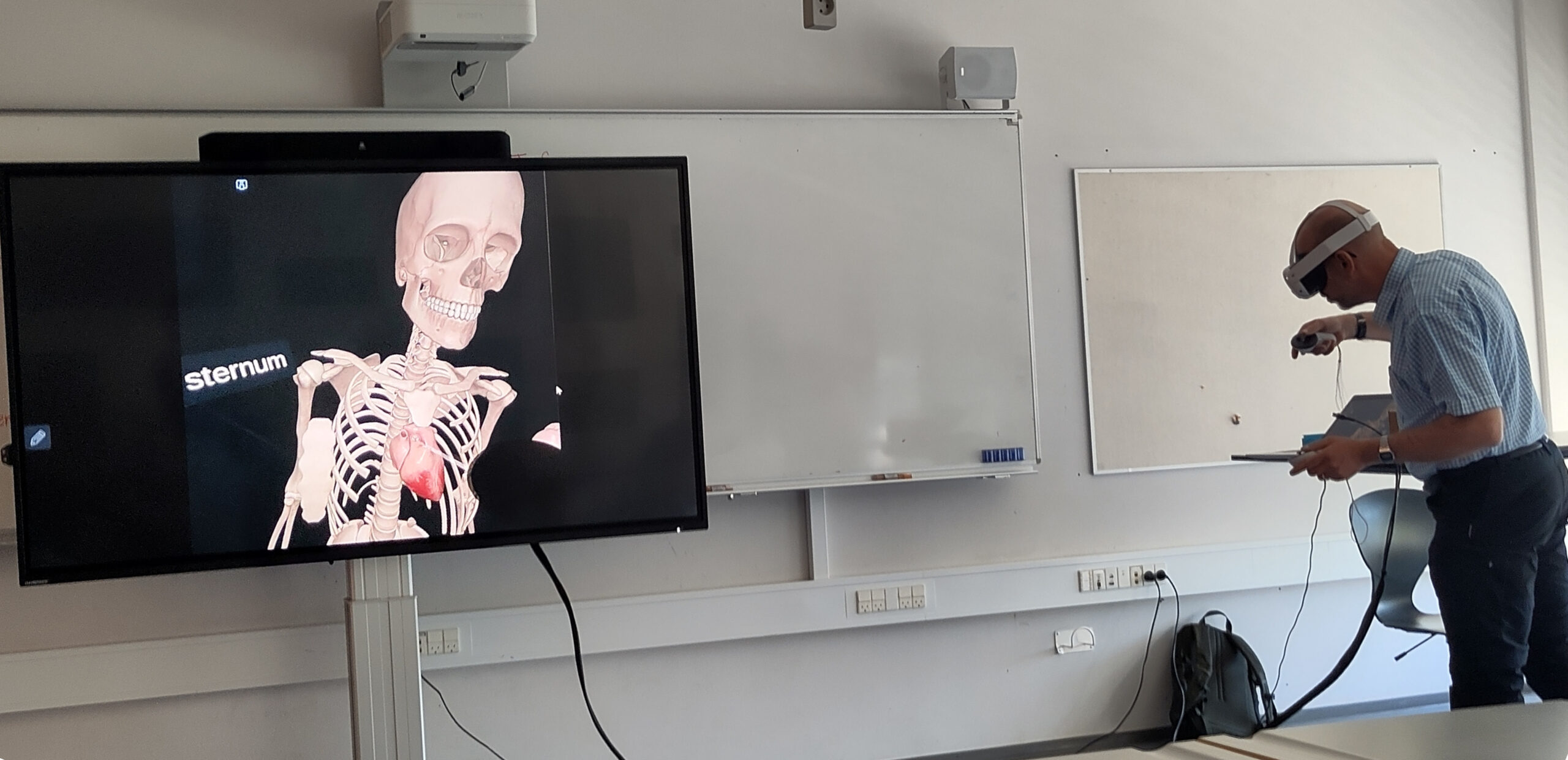DK HTX: “VR glasses in biology lessons”
The teaching module was conducted at Technical High School Svendborg (HTX) in March 2024 with 28 students in 11th grade (1.g). Over three 90-minute biology lessons, students used VR glasses to explore human anatomy and develop their learning products.
The biology module was further refined and implemented as Iteration #2 in three biotechnology lessons for 24 students in 2.g and 3.g (12th and 13th grade) in April 2024. Since then, the module has become an integrated part of the local curriculum and is continuously updated.
Teaching Design
The learning objectives for the module aligned with the general objectives of the educational program:
– Students are able to use relevant digital tools.
– Students are able to express themselves in writing.
– Students are able to use technological terms and professional language.
Mores specifically, students were expected to relate to digital models as representations of human anatomy.
The content and activities of the module were structured as follows:
1) Oral introduction by the teacher:
– Explanation of the goals and tasks, including ´wonder questions´* to explore within the virtual human body
– Introduction to and demonstration of the VR glasses and VR content .
2) Students´ exploration of VR glasses and VR content (in groups).
3) Students´ work with learning products (in groups).
4) Mutual presentations and peer-feedback.
The students´ learning products included a) a written manuscript, b) an mp4-film, and c) an oral group presentation.
Pedagogical methods
The students worked in groups of 3-4. Since the school had only 3 VR glasses available, the groups alternated between different types of tasks.
To ensure active involvement from all group members, students followed their peers’ virtual explorations via projection on one of their laptops and provided commentary on the explorer’s actions in real time.
Evaluations
The teachers evaluated the methods based on their impact on students’ learning. They agreed that the added value of VR technology depends significantly on the didactic approach.
There was clear appreciation for the spatial visualization that VR glasses offer, as this unique feature enhances students’ understanding of 3-dimensional processes. Alternative physical 3D models and methods tend to be more costly and less flexible to handle.
At the time of testing, VR was still relatively new to students and sparked both technological interest and motivation. However, teachers recognized that this initial excitement would likely diminish over time.
The two teachers involved in the module, agreed that although the initial setup requires a time investment, this specific module provides an opportunity to work with students’ understanding of the connection between anatomy and physiology in a new and different way, where technology has become part of the subject’s overall toolbox.
The teachers expect to utilize this new technology in other areas, such as enhancing students’ understanding of scale at the cellular level and visualizing biological macromolecules in a more powerful, spatial way.
Those were some fun lessons!
Students, 1. g, HTX Svendborg
Students´ learning products
Recorded student´s exploration of virtual human body, March 2024 (2 min., in Danish)
The video illustrates authentically a student group´s work. Throughout the video, a laptop can be seen where the group can “follow along” with what the student wearing the VR headset experiences.
2 other group members contributed to the planning and script. They appear briefly, but otherwise, they stayed behind the camera during the recording.
This group chose to record with “passthrough,” allowing the classroom to be visible. The “traffic” in the video consists of other students working simultaneously on different experiments.
*Teacher´s ´wonder questions´ as trigger tasks for the students
“How is the body able to regulate blood supply when going outdoors in the cold?”
“How can you prevent heat loss from the body when playing football in winter while wearing shorts?”
“I wonder why so many Danish men who undergo surgery for prostate cancer later experience issues with involuntary urination?”
ROBOdidactics

In relation to ROBOdidactics, the teachers emphasized the student-centered approach promoting an active personal use of technologies.
Digital production
The chosen technologies included Meta Quest 3 VR glasses, along with VR content focused on human anatomy.
The students´ laptops were essential to ensure that all group members could actively participate while one student at the time explored the VR content.
Methods Applied
Students utilized an integrated VR functionality to screencast their explorations of the virtual human body. The automatically generated MP4 videos were then edited based on their own manuscripts, created in response to the teacher’s ‘wonder questions’*. For this purpose, students applied skills acquired in the HTX subject “Communication and IT.”
The value of these technologies depends on the didactic approach, particularly in enabling teamwork around an individual technology. The approach was both playful and structured, ensuring a directed and purposeful learning experience.
VR glasses do not allow student groups to experience the same reality simultaneously. However, we have developed a method that makes the experience as immersive as possible.
Claus Borre, lecturer HTX Svendborg
In the long term, we also dream of translating our current experiences and opportunities into the development of small, game-like sequences that animate, for example, the function of the immune system at the cellular level.
Claus Borre, lecturer HTX Svendborg
Digital literacy
Digital literacy was not explicitly addressed in this module, except through the conscious, practice-oriented work within communities of practice. Thus, students took on clear roles during the exploration phases and collaborated with a focused approach toward their joint learning products.
Additionally, the module contributed to the students’ technological actionability by placing VR glasses in a professional context. Before the module, only few students had used VR glasses, and only for gaming purposes.
Environment
During the teaching module outlined, there were no explicit references to the outside world. However, the use of emerging technology helped prepare students for their future studies and careers, contributing to their career learning.
As a follow-up activity, the 3rd-year biotechnology students (HTX 3. g) visited university college UCL, where they were introduced to how the same technology is used in practice in higher healthcare education programs. One of the HTX 1st-year classes later visited UCL in their 2nd year, where they worked hands-on with similar technology. At UCL, this technology is used, for example, in radiography training, where it is applied before taking X-ray images of people.
Based on all their experiences, the teachers plan to collaborate with engineering studies within the education chain to jointly produce new VR content.
We envision a future of close collaboration with students from academic programs. We could act as ‘customers’ for them, while they provide us with their use cases.
Claus Borre, lecturer HTX Svendborg
MYRE DK-DE has received financial support from PKP | Interreg Deutschland – Danmark.
In addition to the 35% co-financing, the three project partners have contributed significant own resources and engaged a wide range of network partners.




